Looking for simple and easy ways to teach your child to write?
Not sure where to begin? Check out these simple & easy activities that can help your child learn to write!
Do children want to lean to write?
For young children, learning to write can be a drudging process. There are many things that go into teaching young children to write. Can you just give them a pencil and let them figure it out and explore writing on their own? Sure you can. But unfortunately, most children will either stay away from writing letters or get tired of writing and making the same shapes and scribbles over and over again. By all means, it is a good idea to give children various writing tools and let them creatively “write” things on their own. Just know that at some point though, there will need to be some sort of formal introduction to the writing process for children, so that they are able to form the letters correctly and legibly.
There are many activities that young children can engage in as a way of introducing them to the process of writing. The activities listed below are not an all inclusive list of activities; it is just an idea of what a teacher or parent can do to help introduce children to the world of writing. The beginning stages of writing begins with the practicing of properly holding the writing tool; as well as pre-writing exercises that will help develop their fine motor skills. These activities are normally found in the Practical Life area in a Montessori environment.
This post may contain affiliate links. I may earn compensation when you click on the links; at no additional cost to you. Please see the disclosure policy for more information.
The old debate: Upper case letters vs. Lower case letters
I know that there has also been this life long debate on if the first introduction to writing letters should be upper case letters. Many people have debated that writing upper case letters are easier than writing lower case letters. People who support teaching to write upper case letters first feel that forming curves, loops, and circles is harder than just forming mostly straight lines; as with most upper case letters. As a teacher who has taught many children to write during my teaching career, I disagree with this line of thinking. If children are first given opportunities to freely and actively engage in pre-writing activities, they will have no problem with learning to write the lower case letters; and eventually the upper case letters as well.
Things to consider…
Before introducing actual letter writing and the formation of the letters, it is a good idea to provide opportunities for children to trace shapes or objects. DIY shape tracing sheets are a great way to introduce young children to writing. These shape tracing sheets are laminated and the children use a washable marker to trace the shapes. Once complete, they use a wet sponge and wipe the sheets clean. Laminating them and using washable markers allows the sheets to be reused time and time again. Other alternatives for tracing shapes are letter tracing and number tracing.
When initially introducing tracing to children, you should start by having them use fat markers, fat pencils, and fat crayons. For their small hands, it will make it easier in the beginning for them to grasp and hold the writing tool. Also, providing young children the opportunity to create and write creatively is important. Provide various writing tools and blank paper, so that they can practice making shapes; and eventually letters on their own.
Related post: Montessori Practical Life color mixing activity
Another good tool to use are stencils. Larger stencils of various shapes, animals, and letters are good for writing practice and for pencil grip functions. The small letter stencils provide more of a fine motor practice of writing and still allows the children the freedom to explore creatively and independently. You could provide a variety of stencils. Letters, numbers, shapes, and animals are examples of the types of stencils that can provide children practice with tracing and writing.
Here are more activities that can help children learn to write
Letter Formation Tray
Letter Formation Sand Tray. Sand trays are a great way for children to practice forming letters and numbers. Have an example of the letter or number they should practice next to the sand tray. Copying a letter or number in the sand gives children a tactile way of writing and forming letters and numbers.
Related post: 10 DIY fine motor activities for children
Chalkboards
Chalkboards are a great way for children to experiment on their own and practice writing and forming of letters and numbers. Chalk provides an alternative to traditional writing and gives children the opportunity to create on their own. You can provide samples of letters, lines or shapes for them to copy on the chalk boards.
Letter Tracing Books
Letter Tracing Books are another great way for children to learn and practice the proper way to make and form letters. These letter tracing books instruct children the proper way to form letters. Many people are unaware that there is a proper way to form each letter.
In the end
These activities along with providing opportunities for children to self explore freely with writing will set them on the path to learning how to write. Please remember that each child develops at their own developmental pace, and as individuals, they will begin to write when they have developed these skills naturally. Having these activities readily available will hopefully entice your child to become interested in learning to write. The Montessori principle is that as a teacher or parent, you follow the child, so it is important to do so.
Related post: Bubble Making…a fun & easy Montessori Practical Life activity
Have any particular ideas or activities that you have used to teach your children to write? Please share them in the comments, I would love to hear your thoughts!
Anitra J.


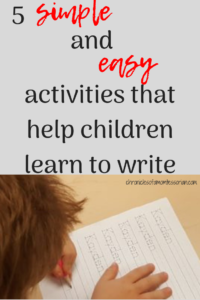
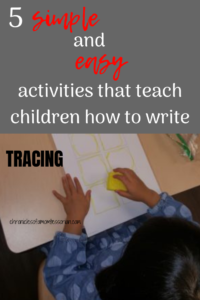
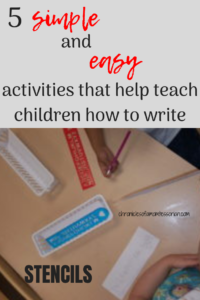

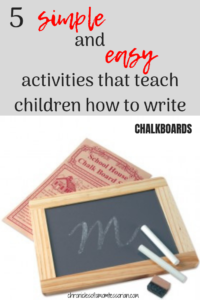
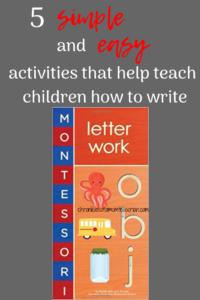
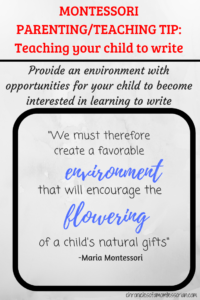



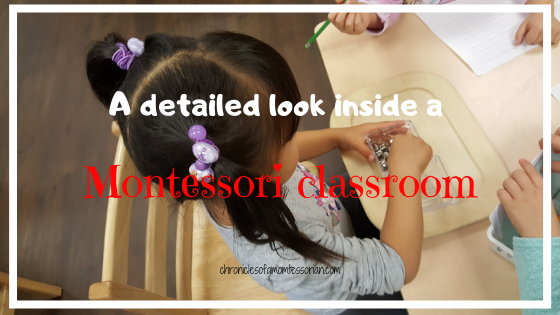
When they were small I found what they liked best and drew with a black marker dots to join on white paper and my friend laminated them so dot joining could be done with a white board marker and rubbed clean to be used again. One loved creepy crawlies so a spider a worm a snail a dinasaur etc … my daughter liked clothes and faces so. … a head without a mouth, a dotty dress shape, a skirt, a hat and a flower. My youngest son liked vehicles so … a wheel, a car a plane a train a roller skate and a skateboard. Some were numbered dots some were unnumbered and some were drawn for copying/tracing. Then letters and numbers. I was lucky to have someone to laminate them so they lasted years. I remember still playing memory games with the cards under a cloth when mine were 10years old. Some ideas last ages.
These look like really great tips to help teach kids to write! I love the sand idea!
You did a superb job explaining to parents/caregivers and providing great examples. Thanks for sharing!
I wish my parents knew all of these tips whilst I was growing up. Granted I was okay at writing but this would have helped a lot!
i love this whole approach to writing. we just started using sand ourselves!
Using stencils is a great idea! I let my son do some simple shapes and he enjoyed it. Now, we’re practicing some shape tracing on a workbook. He has been showing more interest lately. 🙂
As the mother of a three year old boy who is reluctant to do lots of drawings, your ideas hit the jackpot! I am a former elementary teacher, so I have been starting to get worried about his development of small motor skills. Thank you for this informative post!
I love your ideas. Especially the sandbox – how fun is that?! Melissa and Doug has a Water Wow for letters! I think it could be a fun addition to your ideas.
These are all great tips. I didn’t even think about some of these and will definitely be using them with kids.
Thank you for the great tips! My son is 3, but he knows all of the letters (upper and lower case), though he struggles with holding a pen/pencil, He’s also working on tracing shapes. I LOVE the tracing sandbox! What a brilliant idea, especially for younger kids!
I love that you listed several ideas that work into writing. My 2 1/2 year old copies everything we do so the chalkboards would be perfect for her to watch and follow our movements!
Lots of great ideas.
I need to implement them at home over the summer with my kiddo.
She never really showed much interest in these activities at her Montessori preschool, so maybe I will be able to make it fun for her.
Having a variety of tools is important to keep the child’s interest and to find what works best for each individual!
Yes Julie, it’s al about nurturing each child’s individual level
Wonderful, child-centered writing tips! Kids seem to enjoy the variety of writing tools like markers, white-boards, chalk boards, and paper. Writing in sand, is always a favorite.
I love the letter formation tray! I’ll be using that for my daughter in the near future.
These are really great ideas. It’s so much easier to learn when it’s done in a fun way
Thank you for these great tips! My son is starting VPK this August so this will definitely help get him ready for that.
These are great ideas. It does take several methods of practicing before the children finally get the hang of it.